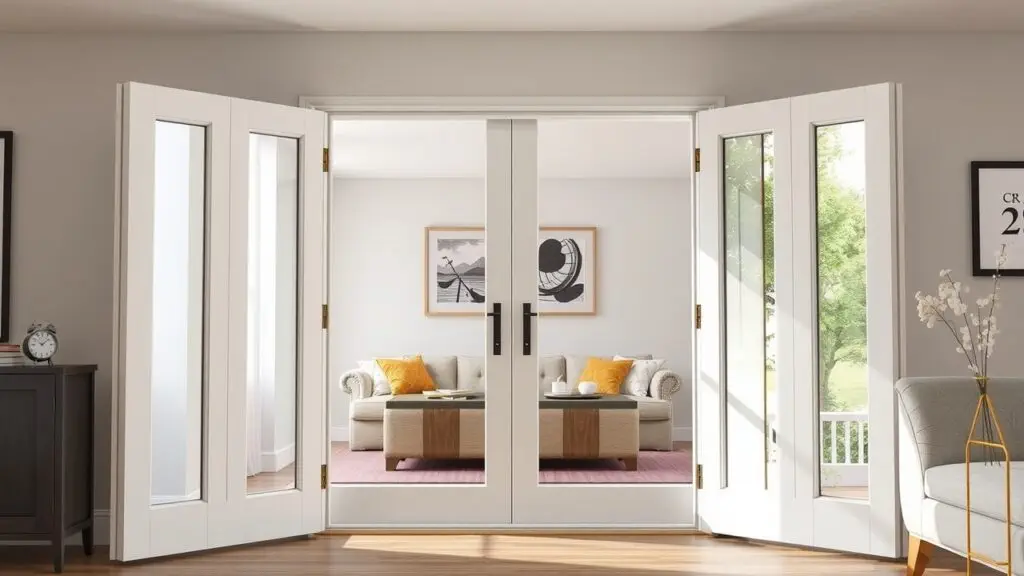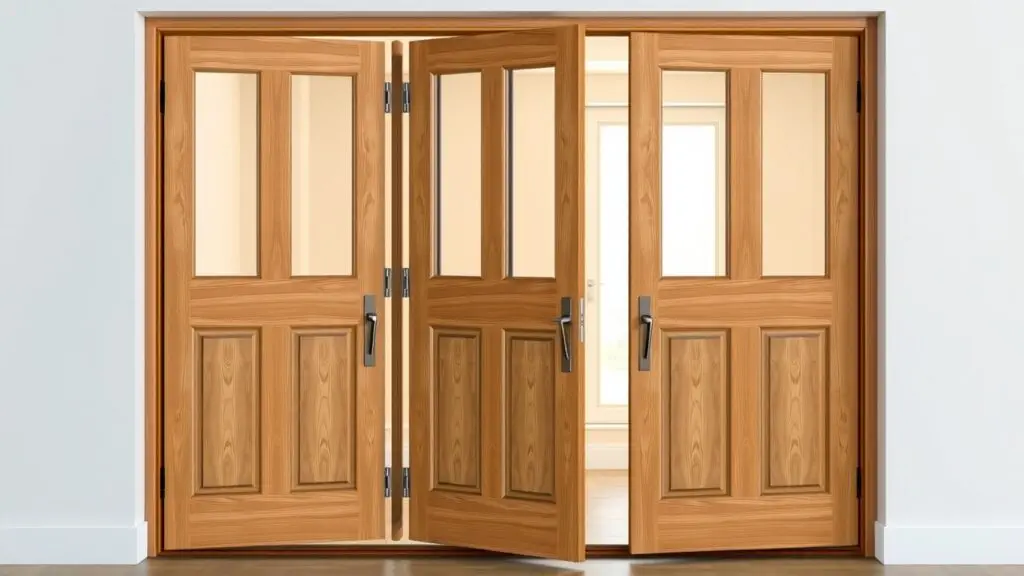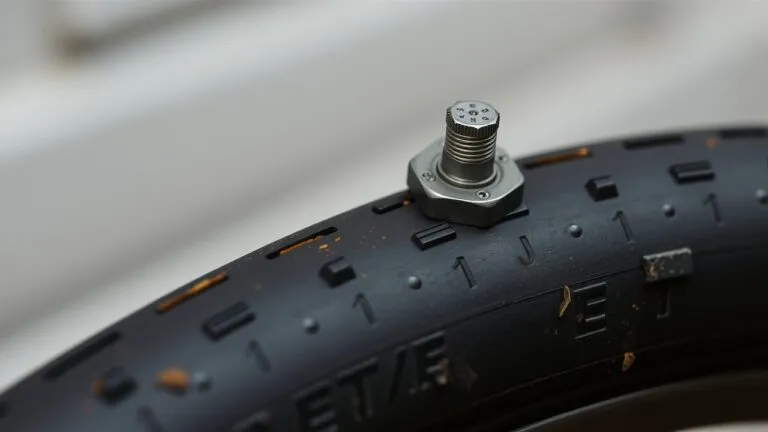This guide covers all types of bifold doors for interior and exterior use, including hardware, installation, and FAQs to help you choose the best option for your home.
What Are Bifold Doors?

Bifold doors are flexible door systems with several panels joined by hinges. When opened, the panels fold to the side, resembling an accordion or concertina. This design allows for a wide opening, making them suitable for both interior and exterior uses.
There are different types of bifold doors to meet various needs:
- Interior Bifold Doors: These work well as room dividers or for closet access, helping create open living spaces.
- Exterior Bifold Doors: These are perfect for patios or garden entrances, adding charm and functionality to outdoor areas.
- Material Choices: Common materials include wood, aluminum, and glass. Each material brings its unique look and durability.
Knowing about the different folding door types helps homeowners pick what suits them best.
Benefits of Using Bifold Doors in Homes and Commercial Spaces
Bifold doors come with many advantages that can enhance homes and businesses:
- Natural Light Flow: These doors let in plenty of natural light while keeping privacy when closed.
- Smooth Indoor-Outdoor Connection: They help create an easy flow between indoor spaces and outdoor areas like patios or gardens.
- Energy Efficiency: Many modern bifold options feature energy-efficient designs, helping to keep indoor temperatures steady by reducing drafts.
These benefits make bifold doors a popular choice for improving any space.
Common Applications: Interior vs. Exterior Use
Bifold doors can be used in various ways depending on whether they are inside or outside:
Interior Uses:
- Room Dividers: Great for splitting open spaces without blocking light.
- Closet Access: Offers easy entry while taking up less space than regular swinging doors.
Exterior Uses:
- Patio Entrances: Ideal for connecting living rooms with outdoor areas.
- Garden Gateways: Provides a stylish entry point into landscaped spaces, boosting curb appeal.
By knowing these applications, homeowners can choose the right style that fits their needs best.
Types of Materials for Bifold Doors
Wood Bifold Doors
Wood bifold doors bring a warm touch to any room. Popular choices include oak, pine, and mahogany.
Popular wood types
- Oak Bifold Doors: Oak is tough and long-lasting, making it a great option for traditional looks.
- Pine Bifold Doors: Pine is lighter and cheaper. It’s easy to paint or stain to fit your style.
- Mahogany Bifold Doors: Mahogany offers a rich color and is very durable but can be pricey.
Advantages
Wood bifold doors look beautiful. They also provide good insulation. This means they help keep your home warm in winter and cool in summer. They are energy-efficient bi-fold doors, enhancing thermal efficiency.
Disadvantages
On the flip side, wooden bifold doors need regular upkeep to avoid problems like warping or cracking. They are also sensitive to moisture damage if they aren’t sealed correctly.
Vinyl Bifold Doors
Vinyl bifold doors, made from PVC, are gaining popularity for places like bathrooms and laundry rooms.
Characteristics and common uses
These interior folding doors are practical and flexible in design. They work well where moisture resistance is important.
Pros
The main benefits of vinyl bifold doors are their low price and little maintenance needed. They resist moisture effectively, making them perfect for humid areas.
Cons
However, vinyl options often have fewer design choices compared to custom-designed bi-folds in other materials.
Aluminum Bifold Doors
Aluminum bifold doors add a modern touch with their sleek look. They’re perfect for contemporary homes or outdoor spaces.
Features that make aluminum suitable
Their lightweight yet sturdy nature allows for big openings without losing strength. Contemporary bi-fold designs often feature slim frames that maximize views while keeping your space secure.
Strengths
Aluminum is resistant to corrosion. This makes it last longer even in rough weather. The strength of aluminum helps these door systems work smoothly over time.
Weaknesses
Yet, aluminum bifolds can dent easily if hit hard. Plus, they might not have the traditional look some people want when choosing industrial-style bimfolds instead of warmer wood options.
Glass Bifold Doors
Glass bifold doors open up spaces by letting in natural light while blending indoor and outdoor areas seamlessly.
Types of glass used
You can choose between clear glass bfold door options for a wide view or frosted glass bfold door alternatives that provide privacy while still allowing light in.
Key benefits
These doors are great for maximizing light flow in your home. They also create space-saving solutions when fully opened against each side frame during gatherings or daily activities!
Drawbacks
But keep in mind that glass can be fragile; you might need repair tips if an accident happens. Installation costs can also be higher than other materials mentioned earlier!
Panel Configurations Explained
Standard Folding Panels in Bi-Fold Systems
Standard bifold doors are a favorite for homes and businesses. These doors have multiple bi-fold door panels that fold back to create an open space when needed. People often call them concertina doors. They come in many materials, like wood or glass, which lets you choose what fits your style.
When looking at folding door types, knowing the options helps a lot. Standard bifold systems usually have two or more panels that slide along a track system. This setup allows smooth operation and brings in natural light when the doors are open. Interior bifold doors are great for spaces like closets or room dividers. Meanwhile, exterior bifold doors make a lovely entryway to patios or gardens.
Key Features of Standard Bifold Doors:
- Versatility: Good for homes and businesses.
- Space-Saving Design: Great for tight spots where regular doors can’t fit.
- Aesthetic Appeal: Available in various styles and finishes to match any decor.
Sliding or “Bypass” Panels
Sliding bifold doors work differently than standard ones. Instead of folding in, these panels slide over each other. This design is handy for small spaces where a full opening isn’t possible but still allows access without needing extra floor space.
These sliding mechanisms usually have rollers that help the panels glide along their tracks easily. They can be set up as single-track systems with two panels or multi-track systems with several panels lined up together.
Advantages of Sliding Bifold Doors:
- Efficient Use of Space: Perfect for narrow hallways or compact rooms.
- Easy Operation: Smooth movement with less effort needed due to roller systems.
Stacking Options
Stacked bifold doors present another option within bi-fold door frames. When these doors open, all the panels stack neatly to one side instead of just folding outwards like traditional models. This method makes openings larger and gives you clearer views when they’re fully opened.
The number of bi-fold door panels affects how much space you save when they stack away, typically ranging from three to eight panels based on your needs and the size of the area where they will be installed.
Benefits of Stacked Bifold Doors:
- Maximized Openings: Creates wide passageways, perfect for gatherings.
- Flexible Configurations: Can fit different widths depending on your project needs.
Knowing about these panel configurations can help you choose the best type for your home improvements while making sure they fit well with your style and needs.
Bifold Door Hardware: Functionality and Aesthetics
Bifold doors are great for homes and businesses. They combine style and practicality. The right bifold door hardware is key to smooth performance. It also adds to the look of your space. Knowing the types of bifold door hardware helps when installing them.
Types of Hardware
Choosing bifold door hardware means looking at different parts that help it work well:
- Tracks: These help guide the doors.
- Hinges: They connect the door panels.
- Pivots: These let the doors swing open easily.
- Rollers: They help doors slide smoothly.
Top Pivot
Top pivot systems are built to provide good support. They hold most of the weight at the top. This type works well in homes, like in closets, and in commercial spaces needing space-saving solutions. They allow easy opening without taking up floor space, making them perfect for busy areas.
Bottom Pivot
Bottom pivots help with heavy-duty applications by anchoring the bottom of each door panel. This system spreads out weight evenly, especially for bigger bifold doors made of heavy materials like wood or glass. Bottom pivots guarantee long-lasting strength.
Hinges
Hinges come in many designs for folding doors. Some are hidden, giving a neat look, while others might be more decorative. Picking the right hinges makes sure doors stay aligned and work properly over time.
Tracks
The type of track you choose impacts how well your bifold doors move:
Floor-Mounted vs. Ceiling-Mounted Options
Floor-mounted tracks offer strong support but can be tricky if you want to change your flooring later; they might need regular cleaning from dirt buildup. Ceiling-mounted tracks keep your floors clear but need precise installation since any mistake can lead to problems later.
Rollers
Roller systems boost functionality by allowing smooth movement on tracks:
Roller Types
Different rollers exist based on material—nylon rollers are usually quieter, while metal ones are stronger under heavy loads.
Maintenance Tips
To keep your rollers lasting longer, clean them often using mild soap and water, then lubricate them with silicone spray or similar products every few months. This stops dust from building up and helps them work well over time.
By knowing these aspects related to bifold door hardware choices—including different types available—you’ll feel ready when it’s time to pick during renovations or new projects!
Choosing the Right Bifold Doors: Key Considerations

When picking bifold doors for your home, it’s good to think about a few key points. These points can help you find the right fit for your style and needs.
Budget: Cost Range for Different Materials
The price of bifold doors can change a lot based on what they’re made of. Here’s a simple price list:
| Material Type | Estimated Price Range (per door) |
|---|---|
| Wood Bifold Doors | $300 – $2,000 |
| Aluminum Bifold Doors | $400 – $3,000 |
| PVC Bifold Doors | $200 – $800 |
If you’re on a budget, PVC or cheaper wood can be great choices. Custom-designed options in wood or aluminum might cost more but usually look better and last longer. Finding a balance between quality and price is key when choosing bifold doors.
Home Style: Matching Bifold Doors to Existing Décor
Bifold doors come in many styles that fit different home designs:
- Modern Bi-Fold Doors: These have sleek lines and simple frames.
- Traditional Bi-Fold Doors: Often made from solid wood with classic details.
- Contemporary Bi-Fold Doors: Mix modern materials like glass and metal for a fresh vibe.
Think about how each style works with your home decor. This helps create a unified look throughout your space.
Maintenance Level: High vs. Low Maintenance Materials
Different types of bifold doors have different upkeep needs:
- Wood Bifold Doors: Need regular painting or staining to avoid moisture damage.
- Aluminum Bifold Doors: Generally low maintenance; just clean them occasionally.
- PVC Bifold Doors: Very low maintenance; they resist rot and are easy to clean.
Choosing materials that are easier to maintain can save you time and effort in the long run, especially if you don’t want to spend much time on upkeep.
Climate: Moisture Resistance and Weather Considerations
Your local climate is super important when picking bifold doors:
- In humid areas, opt for moisture-resistant materials like aluminum or treated wood.
- If you live somewhere cold, insulated bi-folds work best as they keep heat in.
Knowing your area’s weather helps you choose a door that lasts longer and performs better over time.
Location (Interior vs. Exterior): Material Suitability for Different Environments
Where you place the bifold doors also matters:
- Interior Folding Doors are usually lighter options like wood or PVC that divide rooms without taking too much space.
- Exterior Folding Doors, like patio bi-folds, should be sturdy enough for outdoor conditions—aluminum is often the best choice because it’s strong and resistant.
Selecting the right materials ensures your bifolds function well whether inside or outside while looking good too.
Intended Use: Room Dividers, Closet Doors, Patio Enclosures
How you plan to use the bifold doors will guide what features you need:
- For room dividers, go for lightweight designs that let you change layouts easily.
- When choosing closet bifold doors, pick compact styles that give easy access while staying stylish.
- For patio bifold doors, focus on energy-efficient models built for outdoor use, creating smooth connections between indoor areas and patios.
Understanding how you’ll use the bifolds helps you make better choices that fit your needs while ensuring satisfaction with their performance over time.
Bifold Door Installation: DIY vs. Professional
DIY Installation: Basic Steps and Considerations
Installing bifold doors can be a fun project for homeowners. If you enjoy home improvement tasks, here are some basic steps to follow for DIY bifold door installation.
- Choose Your Doors: Start by picking the type of bifold door you want. It could be wood for a cozy look or glass for a bright feel. Knowing the different styles is key to both looks and function.
- Gather Tools and Materials: Before you start, collect all the tools you’ll need. This includes a level, measuring tape, drill, screws, and hinges that match your bifold door hardware.
- Measure Your Space: Accurate measurements are super important for installation success. Measure the height and width of the opening where you want to install the doors to make sure they fit well.
- Prepare the Opening: Clear any stuff from around your doorway. Check that it is square (equal on all sides). If needed, make changes to create a level surface.
- Install Track System: Most bifold doors use a track system at the top. Follow the manufacturer’s instructions carefully during this step so your doors operate smoothly later on.
- Hang Doors: After installing the track, hang each panel according to the instructions provided with your door kit. This usually means attaching them directly onto rollers in the track system.
- Adjustments: Once all panels are hung, align them so they open smoothly without sticking or dragging against one another or surrounding surfaces.
Many find success with DIY installations of interior bifold doors because their design is often straightforward. However, installing exterior doors may take more skill due to weatherproofing and structural concerns.
Professional Installation: Benefits and When to Hire a Professional
Hiring professionals for bifold door installation can offer many benefits that might outweigh the cost of doing it yourself:
- Expertise in Complex Installations: Professionals know how to handle different types of bifold doors, including those that need special framing techniques for proper fitting in tricky spaces.
- Time Efficiency: A skilled installer can finish jobs much quicker than most homeowners can while also keeping disruptions low during installation.
- Quality Assurance: With professional help, you get peace of mind knowing that everything meets industry standards. This reduces risks like drafts or misalignment from improper fittings.
- Warranty Protection & Support Services: Many manufacturers give warranties only if their products are installed by certified pros. So hiring experts not only protects your investment but also offers support if issues come up later.
Measuring Your Space: Accurate Measurements for Success
Getting accurate measurements is key when choosing bi-fold door sizes for any space in your home:
| Measurement Type | Description |
|---|---|
| Width | Measure across three points (top/middle/bottom) to ensure uniformity |
| Height | Check from floor to header frame making sure there are no obstructions |
| Depth | Assess how far back wall recesses for enough clearance when opened |
Taking precise measurements helps avoid costly mistakes related to mismatched sizing that can waste materials and time! Always double-check before buying new units since returning wrong orders might incur extra fees depending on retailer policies!
Bifold Door Maintenance and Repair
Maintenance Tips for Each Material Type (Wood, Vinyl, Aluminum, Glass)
Keeping your bifold doors in good shape is really important. Each type of door material has its own way to care for it.
Wood Bifold Doors: To maintain wood bifold doors, check for wear or damage regularly. Clean them with a damp cloth. You can also use wood polish to keep the finish nice. Make sure to inspect the hinges and tracks too, so they open and close smoothly.
Vinyl Bifold Doors: These doors don’t need much work, but it’s good to wipe them down with mild soap and water sometimes. This helps prevent dirt buildup. Also, check the seals often to make sure they resist moisture well.
Aluminum Bifold Doors: For aluminum bifold doors, a soft cloth works best for cleaning surfaces. Stay away from harsh cleaners that can scratch the finish. Don’t forget to lubricate moving parts from time to time.
Glass Bifold Doors: Use a glass cleaner on the panels to keep them clear. Regularly look over the frames for chips or cracks that might weaken them.
Common Problems and Troubleshooting
Bifold doors can run into some common issues that you should be aware of:
- Sticking Panels: If your panels stick, dirt may be blocking the tracks or they might not be aligned right.
- Difficulty Opening/Closing: Trouble with opening or closing could mean the rollers need some lubrication or there’s something stuck in the track.
- Warped Panels: Wooden panels are more likely to warp; if they are badly damaged, think about replacing those specific panels.
- Damaged Hardware: Check hinges and tracks often for wear; replace any bent or broken parts quickly to avoid bigger issues later.
Repairing Damaged Panels or Hardware
When you need to repair your bifold doors:
- For small scratches on wood, touch-up paint can help fix them up nicely. There are also repair kits available for vinyl and aluminum.
- If you have bigger problems like dents in aluminum frames or shattered glass:
- It’s usually better to swap out single parts instead of changing everything at once.
- If repairs get tricky, consider getting professional help especially for things like frame realignment that needs special tools.
By keeping up with maintenance tips for each material—wooden, vinyl, aluminum—and knowing how to tackle common problems along with repair strategies will help you enjoy your bifold doors for many years. They’ll stay functional and good-looking in your home!
Frequently Asked Questions (FAQs) about Bifold Doors
What are the different types of bifold doors?
Bifold doors come in several types. Interior bifold doors serve as room dividers or closet doors. Exterior bifold doors connect indoors to outdoor spaces like patios. You can choose wood, aluminum, or glass based on style and function.
How do I choose the right bifold door for my space?
Consider several factors when choosing a bifold door. Evaluate your budget and the materials available. Think about your home’s existing décor. Also, consider the intended use—like whether you need a door for a room or patio.
What are the benefits of bifold doors?
Bifold doors provide many benefits. They allow natural light to enter rooms. They also create smooth transitions between indoor and outdoor areas. Additionally, they save space compared to traditional doors.
How much do bifold doors cost?
The cost of bifold doors varies widely. Expect to pay between $300 and $3,000 based on material and design complexity. Custom options may increase the price further.
Where can I buy bifold doors?
You can buy bifold doors at home improvement stores, specialized retailers, and online suppliers. Many manufacturers offer a wide range of styles and materials.
Bifold Door Styles
- Modern Bi-Fold Doors: Feature sleek designs with minimal framing.
- Traditional Bi-Fold Doors: Often crafted from solid wood with classic details.
- Contemporary Bi-Fold Doors: Combine glass and metal for a fresh look.
- Custom Designed Bifold Doors: Tailored to fit specific dimensions and styles.
Bifold Door Hardware
- Hinges: Essential for smooth operation; choose hidden or decorative styles.
- Tracks: Available in floor-mounted or ceiling-mounted options for stability.
- Rollers: Vary by material; nylon is quieter while metal offers strength.
Maintenance Tips
- Regularly clean tracks and lubricate rollers.
- Inspect hinges for wear to ensure longevity.
- Check seals on glass panels for optimal energy efficiency.
Installation Considerations
- Measure openings carefully before purchasing.
- Ensure you have necessary tools such as level and power drill.
- Decide between DIY installation or hiring a professional based on comfort level.
By considering these aspects, homeowners can confidently choose the best bifold door solutions for their needs.
Related Topics
- Types of bifold door materials
- Types of bifold door panel configurations
- Types of bifold door styles
- Types of bifold door hardware
- Types of bifold door installation methods (DIY vs. professional)
- Types of glass used in bifold doors
- Types of wood used in bifold doors



Types of Bifold Doors: A Complete Guide